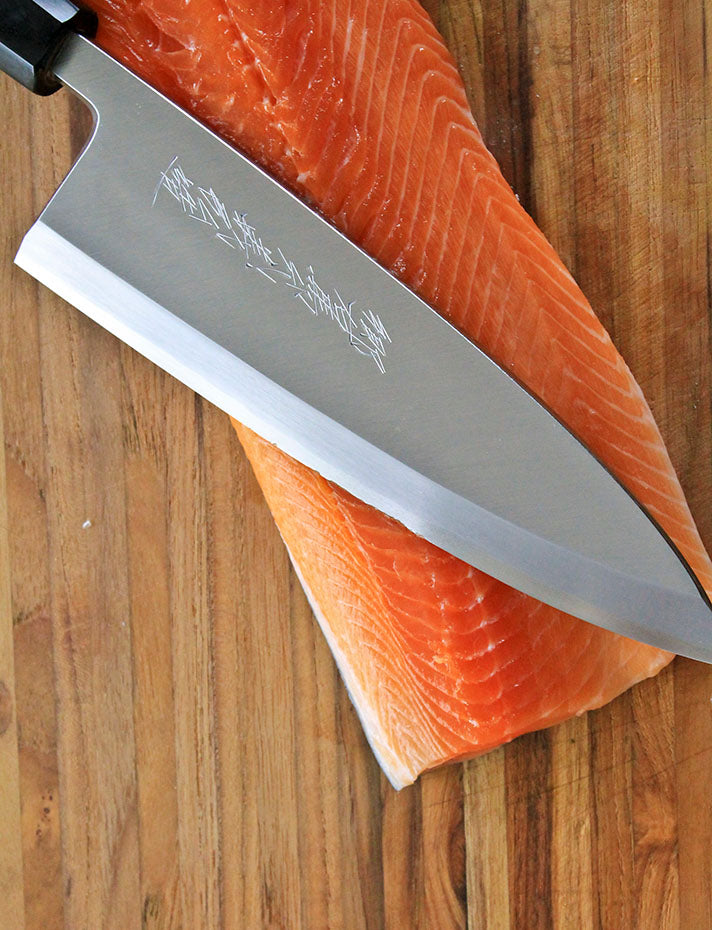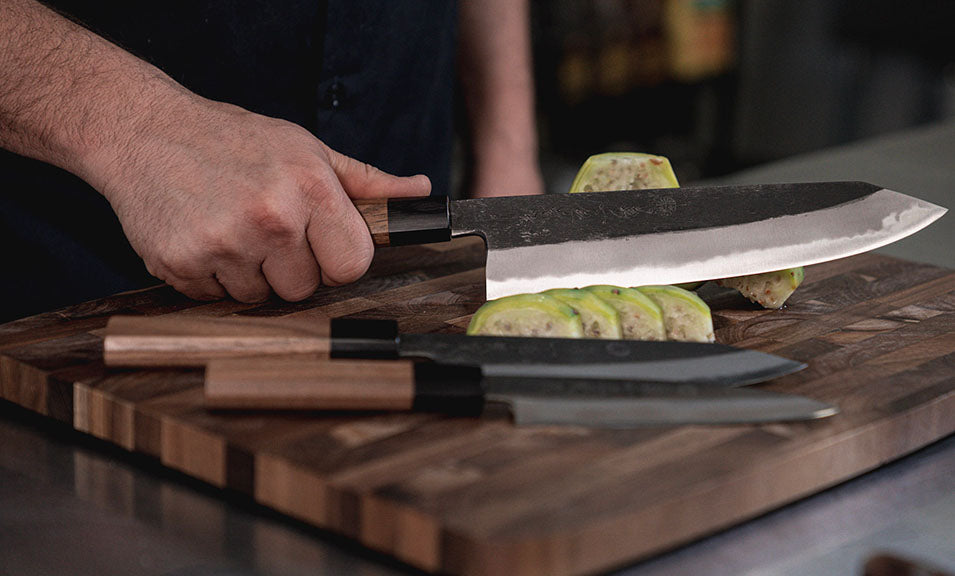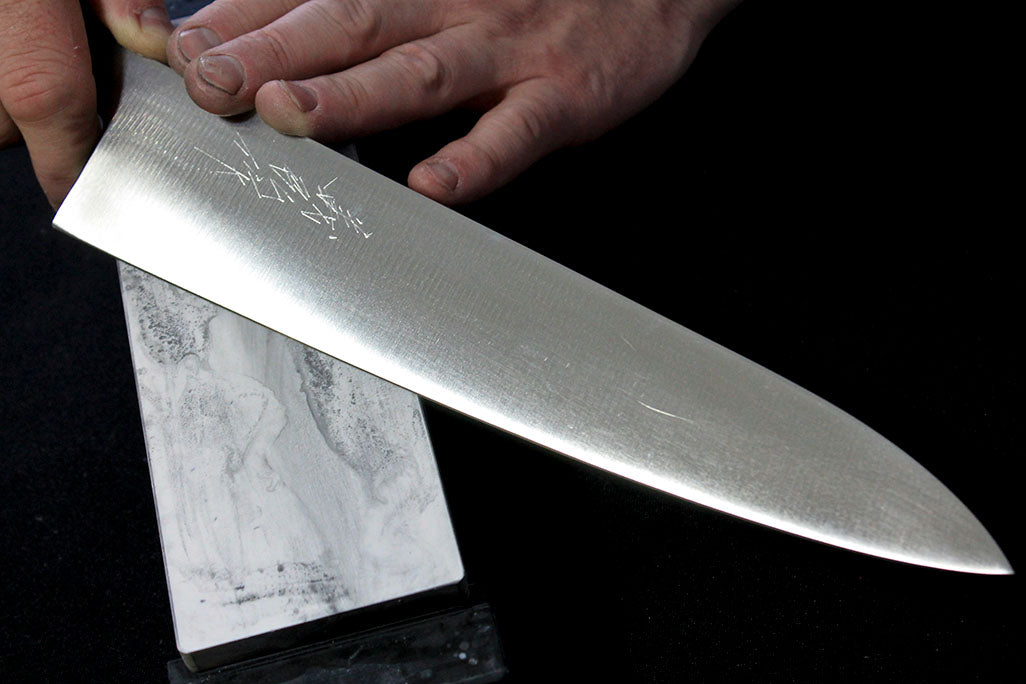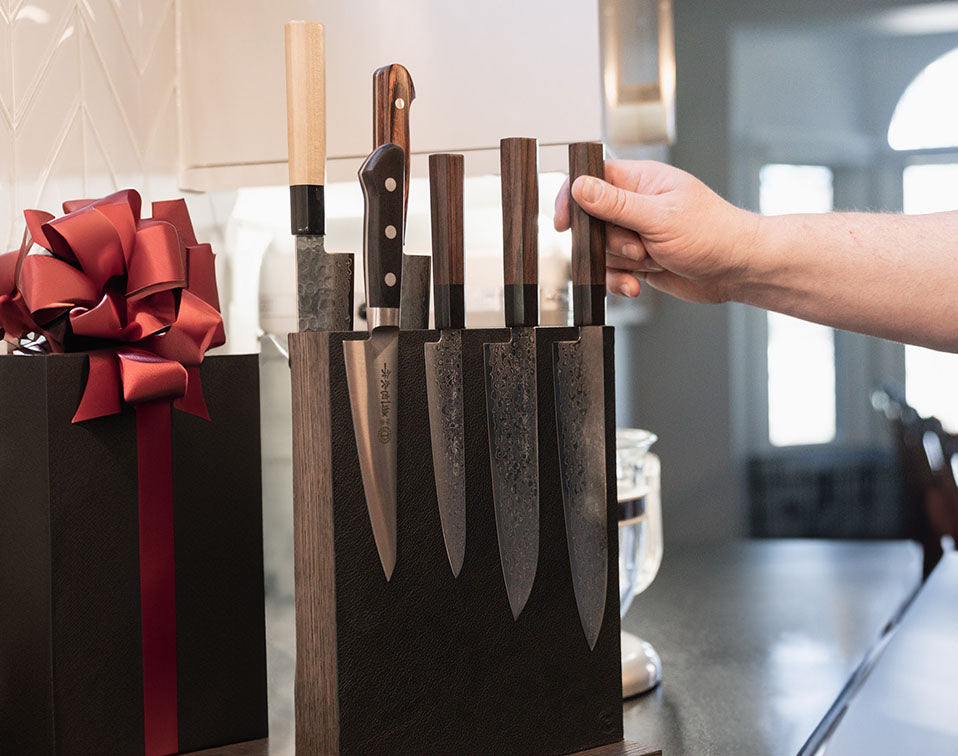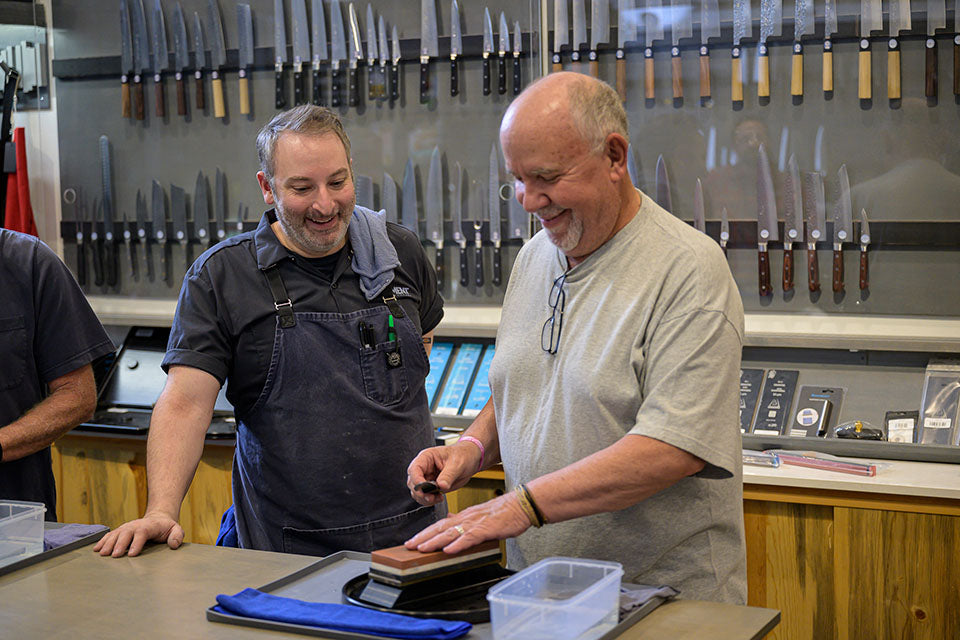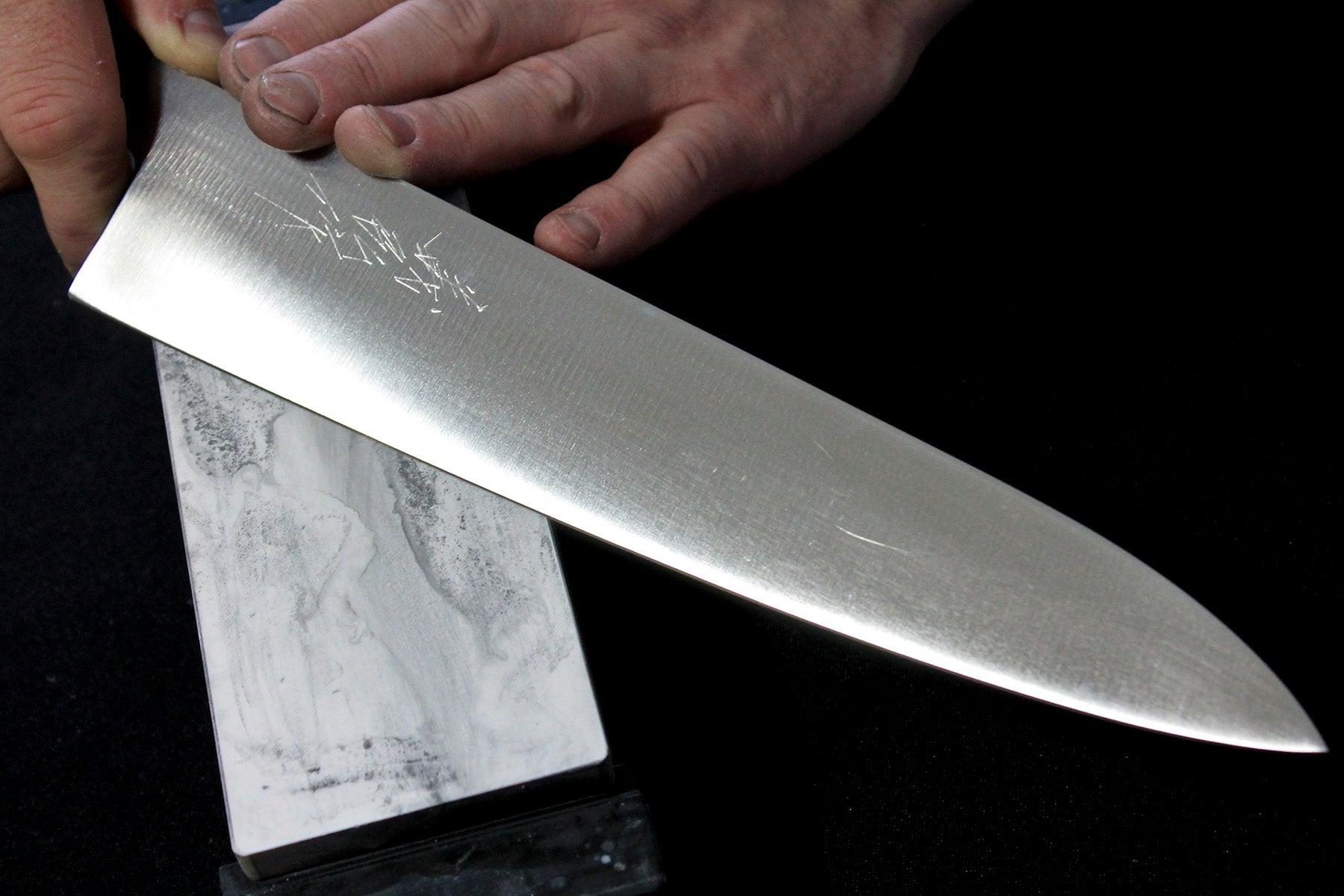
My charmed journey to learning the Lost Art of Sharpening Knives by Hand — ( A short story made long)
Sharper Things
Ever since I was a kid, I have had an affinity for knives. Growing up in the 80s in a small town, we had an annual Labor Day parade and Fair. One of my favorite fair games was the ring toss, and this one had a twist. Survival knives and pocket knives sticking straight out of blocks of wood. You know, the kind that Rambo and Commando brandished. Get enough rings around the right knife, and "here ya go, kid"! My parents were always pissed (Worried and concerned, actually, but pissed from a kid's perspective) when I came home with new shiny stabby devices. And understandably, I was ten years old! The only way I was allowed to keep them was if my dad went out and ground away the cutting edge and point. I'm not sure if, ultimately, that affected me, but as I think back on those dull knives, I shudder at the thought.
Fast forward to the summer of 1995. A week out of high school, I entered a three-year culinary apprenticeship. Part of the tuition was a starter kit of knives. They were the most basic, but I loved them. I saw higher-level chefs with bigger, fancier, shinier knives as I progressed through the program. I was never satisfied and would scrape my pennies together so that I could afford to try out other brands and styles. As my quiver of knives grew and my knife skills improved, knife sharpening remained a mystery! There were a few chefs around with the skills to sharpen; if you begged them, they would reluctantly do yours too.
Sometimes we would make trips down to the cutlery stores in malls for sharpening. Do you remember these? They all seemed to have a giant 3-foot automated Swiss Army Knife with the blades slowly folding in and out. But those guys would always take your knives into the back room, and I could never see how the knives were sharpened, although I heard lots of grinding.
On one occasion in culinary school, my head chef at the time was bragging about his new grinding wheel. He offered to sharpen my knife, and when I got it back a couple of days later, it was a completely different shape (totally unusable). I made a stink about how he ruined my knife, so he reimbursed me for it. I used the money for an upgrade after it was all said and done. It was the first time I realized a significant difference between using a mechanized device and sharpening by hand. It makes sense, of course, where a powered device can remove so much material so quickly if not used correctly. Also, if you're not careful, the blade can get too hot, which will remove the temper.
What's a temper? Temper is hardness, and in a fundamental explanation, steel is heated, quenched, and tempered. The temper provides the desired properties at the end, including a high hardness level in combination with sufficient toughness. The knife is now able to hold an edge very well. The blade will not hold a sharpened edge if you remove the hardness.

A few years later, I was hired as a kitchen manager at a Wolfgang Puck Café. This location was a Grande Café, meaning larger in size, and it was outfitted with a sushi bar. The sushi bar fit into the whole Pacific Rim theme they had going on. It turned out that the sushi bar had lost a chef just before I showed up for my first day of work. They asked if I wouldn't mind helping out for a few weeks, working mornings with the Sushi team, and offering basic support. After my morning shift, I was to continue my duties on the Hotline in the evenings. Not only was it a love affair with knives again, but I fell for Sushi and Japan, and I fell hard!
I had never seen such beauties: high-carbon steel, Japanese-style handles, and knives designed for only one task. The Japanese make a knife for every task. There are knives specific to cutting blowfish, octopus, eel, salmon, tuna, beef, and chicken, to name a few. I quickly realized how ill-equipped I was. I also immediately learned that within the Sushi culture, you sharpen your knives every night at the end of your shift (off the clock). Oh, and by the way, I was expected to own sharpening stones! For me, this was unheard of at this point. All the kitchens I had worked in up to this time seemed to have the same beat-up old oil tri-stones. Half the time, the honing oil was missing, so we'd try to manage using the stones dry or, even worse, using that pink, coconut-smelling industrial dish detergent in place of oil. What an absolute disaster!
The Japanese I trained under all had ceramic water stones, which they would gracefully use and hone their knives to a razor-sharp edge. For the first time, I also witnessed maintaining and caring for sharpening stones. Reluctantly, the old Japanese chefs helped me pick out some Japanese knives and ceramic water stones. I encountered a lot of reluctance among the senior Japanese Sushi chefs. (At least early on, I did). Here's me, a young, cocky white kid infringing on some of their oldest and most honored traditions. But I would like to believe at some point, they admired my persistence. That was a sensibility that was ingrained in us from culinary school. I had decided to excel at sharpening. I would try and try, and try again, to sharpen these knives. I would mimic what I watched from the masters. I would ask a lot of questions and badger them often. It was explained to me that I wouldn't 'really' know how to sharpen a knife until I wore through an entire stone and an entire blade. It took a couple of years, but I finally reached a point where I could almost efficiently and proficiently sharpen by hand on Whetstone. At this point, you may be asking yourself, what is a whetstone? Or is it a wet stone? Great question! The old term for sharpening was whetting. So, all sharpening stones are whetstones, but not all whetstones are wet stones (water stones)… Whet versus wet, got it?
There are different types of sharpening stones made from other materials. Some use lubrication, and some don't. There are dry stones, oil stones, water stones, sometimes called wet stones, and natural stones. Natural stones, of course, are cut from mountainsides or quarried and sourced from around the globe. Otherwise, stones are diamond or synthetic ceramic using materials like aluminum oxide or silicon carbide. I haven't even talked about burrs, honing, grinders, and belt sanders. But I digress…
Read these other three blogs I've written: 'A deeper understanding of burrs,' 'What's the difference between sharpening and honing a knife, and when should you execute them?', and 'Knife Sharpening & The Best Methods.

In 2004, I was working at a Sushi bar in Boulder, Colorado. One of my fellow Sushi chefs was from Japan. He and I became fast friends. When his work visa expired and he had to go back home, he invited me to work and train at the sushi bar owned by his parents where he grew up. This experience solidified that, for me, it would be knives and sushi for life.
During my time in Japan, I had a wide range of experiences, observations, and realizations: some small, some profound. (For example, the small detail of my high-carbon steel knife tarnishes a different color in Japan than in Colorado). I visited tiny cutlery stores with hundreds of knives on the wall--Every shape and style imaginable! At the sushi bar, I would watch and observe a different level of respect given to tools and other inanimate objects. My experience was a stark contrast, having cut my teeth in American and Western kitchens. Upon reflection and realization, there was a broad disregard for handling tools and equipment gently. I developed a deep appreciation for not only the tools but for the craft.
While in Japan, I developed an understanding that the 'micro' does not exist without the 'macro' and vice-versa. They play off one another. For example, it is equally essential to maintain and care for your sharpening equipment so that you can maintain and sharpen and care for your knives. Your knives help you prepare the food you are making for your guests. As a hard-working chef, you deserve to work with the best tools. As a paying guest, you deserve the best meal possible. As an employee, you should give the best to your customers and employer, and in turn, to yourself. As an employer, you deserve to have the best from your staff and give them the best and most they deserve. It's a harmonious outlook.
As I advanced in the restaurant industry making sushi, I continued my quest to understand knife sharpening in the most micro way possible. I treated sharpening and the equipment like I did knives early in my career, trying different brands and techniques. I was reading or learning as much as I could. I was talking to my peers and examining their approaches and methods. Not to sound cliché, but there's something very Zen about knife sharpening. I became fascinated with thoughtful and methodical movements. I learned about paying attention to your body, posture, and breathing and receiving other feedback with your fingers and ears. I followed my gut and intuition. I would, and still do, try to imagine what the steel and burrs look like on a microscopic level while being sharpened. It's pretty easy having a smartphone in your pocket; you can quickly look up information and see images of knives and blades under an electron microscope. All very helpful in understanding.

I believe it's important not to become complacent if you want to continue the quest. You have to stay curious and have wonderment. Ultimately, it is a point of pride for me to be able to sharpen a knife by hand and know that I put a superior edge on a knife. It seems, at least for a while, that sharpening knives by hand has fallen out of favor in the mainstream. Although, I'm hopeful that it's making a comeback, and it seems there is a resurgence of interest once again. Knife-making and forging have become so popular lately. Especially with TV shows like 'Forged In Fire. If you want to learn how to sharpen knives by hand, check out our YouTube channel or take one of our sharpening classes.
- Choosing a selection results in a full page refresh.
!

